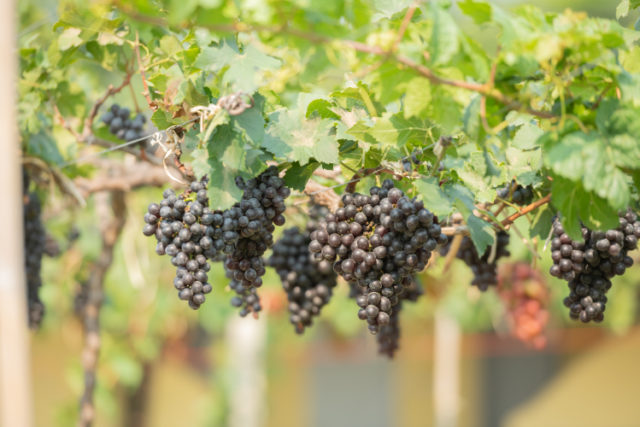
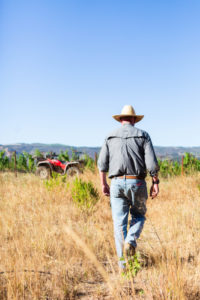
When we caught up with Tom Gamble he was walking along the vineyards with his cell phone in one hand and a Leatherman tool in the other. As he talked to us for nearly an hour, we could hear him lopping off bunches of grapes too green to ever reach maturity by harvest. It is a place where he is most at ease despite the pressure that an impending harvest has on his bottom line.
Gamble can walk as many as five miles a day during growing season to tend to the 175 acres of Napa Valley vines that make up Gamble Family Vineyards. Often toting a binder of contracts, maps and legal documents, today he is more focused on the business end than he was when he tended a variety of crops for previous generations. But no matter how much the details of running a business cram his mind, his heart is still in farming.
“I can’t help myself,” he admitted. “I want to be there at the start of the day because it’s in my blood and it’s what I’ve done all my life. Walking the vineyards clears my head too.”
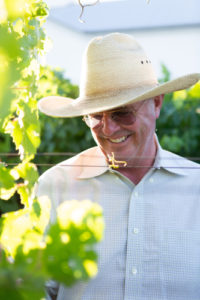
With the start of harvest only two weeks away when we talked to him, his head was full of details: getting the machinery ready, renting scales, buying new picking bins, lining up safety equipment and ATV light towers for nighttime picking, setting up COVID testing for the crew and inspecting the vineyards.
“This is one time to sweat the little stuff,” he said.
The Gamble name in Napa Valley agriculture is a century old. The Gamble family farmed 600 acres when Tom was a kid. But in 1981 at age 20 he and his partners started buying land to finally make a wine with the family name. Today Gamble Family Vineyards owns choice property in Oakville, Yountville, Mt. Veeder and Rutherford AVAs. Its first vintage was 2005.
The prize among Gamble’s vineyards is the three-acre Family Home Vineyard, originally planted by his mother and step-father in 1997. Vines struggle through rock on a small knoll. Picking times vary: soils at the base of the hill are richer, for instance, and have to be farmed differently.
Why someone so deeply rooted in farming would want to make wine is more about economics than ego.
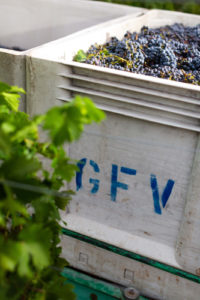
“I love the land and that’s compelling,” he said. “It’s really hard to continue the farming business when it’s just vineyards. To be more sustainable on the economic side, you need to integrate.”
We’re glad he did. Great wine starts with the grapes and that’s something Gamble knows a lot about. While sought-after winemakers and consultants often get the credit for great wine, it’s the crew in the vineyards who start the process. If you don’t have good grapes, you don’t have good wine.
“It is the farmer who works so closely with the winemaker to deliver a product,” Gamble said. “To make a consistent product from inferior grapes, there is so much more winemaker manipulation that has to go into a wine. Our grapes are touched by human hands 11 times in their course. It doesn’t mean you can’t screw up, but once delivered these grapes are going to make great wine. There’s not a lot of need for sorting.”
Although he remains involved in selecting the final blends, he leaves the winemaking to Jim Close, who has been with him for every vintage.
Gamble Family Vineyards were recognized early for its sauvignon blanc, particularly a premium Heart Block version made from two clones of grapes. It is a block that, according to Gamble, “gets the most TLC.” Today, the red wines are getting overdue recognition, but the sauvignon blanc is a consistent over-achiever.
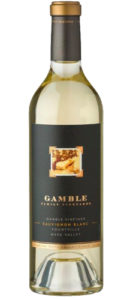
Gamble credits the success to clones, a variety of which you don’t often see in sauvignon blanc. Gamble’s 2020 sauvignon blanc ($35) from Yountville is a blend of four clones. Musque, a clone we love for its creamy and orange marmalade influence, dominates. It’s easily one of our favorite sauvignon blancs next to the pricey Heart Block. Nice texture with classic pineapple and peach notes with a mineral backbone.
The vineyard is also popular with a number of top producers who buy Gamble’s sauvignon blanc grapes. Names, such as Realm, identify each row. Picking times depend on the preferred style of sauvignon blanc. Gamble said it is “really cool” to taste the differences that can come from the same grapes.
“It’s like watching a group paint the same thing but it all looks different. It’s impressionism,” he said. “Diversity is what keeps Napa interesting. Something I think we lost a bit in cabernet sauvignon.”
There’s nothing lost in the 2017 Gamble Family Vineyards Napa Valley Cabernet Sauvignon ($60). Blended with malbec, merlot, cabernet franc and petit verdot, it has a
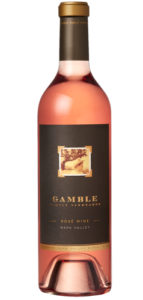
Bordeaux-like style. It has effusive aromas of dark fruit, spice and mint. The palate is ripe and juicy with plum and coffee notes. Complex and firm tannins bode well for its aging potential.
The 2017 Gamble Family Wine Paramount ($90), a blend of cabernet franc, cabernet sauvignon, merlot and petit verdot. The heavy portion of cabernet franc distinguishes the wine from other blends. It is characterized by generous and young red fruit aromas, complex and juicy blackberry flavors with tantalizing hints of tea and herbs.
One of the more refreshing wines in the impressive lineup is the 2020 Gamble Family Vineyard Rosè ($25), an interesting combination of cabernet sauvignon, cabernet franc, pinot noir, merlot and petit verdot. You don’t see that blend too often in rosè.
Wine picks

Trapiche Broquel Malbec Mendoza 2018 ($16). An outstanding value, this Argentinean malbec avoids the rustic quality of some of its brethren. Elegant rich and ripe fruit with classic plum and cherry notes.
Day Owl Rosè California 2020 ($15). A delicious mélange of barbera, grenache, syrah, and french columbard. All stainless steel, this lovely rosè features strawberry and citrus notes in a mouth filling package that should please just about everyone.
Lucia Soberanes Vineyard Syrah 2019 ($60). This wine from the Santa Lucia Highlands takes syrah to a new level. Big, bold and concentrated with jammy blackberry, blueberry and currant notes with layered hints of mineral and black pepper. This is a wine to pair with beef or lay it down in the cellar.
Republished with permission
Tom Marquardt and Patrick Darr have been writing a weekly wine column for more than 30 years. Additional Wine reviews on MoreAboutWine
All photos are randomly selected and do not indicate any preferred wine. Listed prices are subject to change
You can send questions to Tom Marquardt mailto:marq1948@gmail.com
Always drink responsibly![/vc_message]












